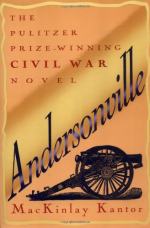Then the stumps were attacked for fuel, and with such persistent thoroughness that after some weeks there was certainly not enough woody material left in that whole fifteen acres of ground to kindle a small kitchen fire. The men would begin work on the stump of a good sized tree, and chip and split it off painfully and slowly until they had followed it to the extremity of the tap root ten or fifteen feet below the surface. The lateral roots would be followed with equal determination, and trenches thirty feet long, and two or three feet deep were dug with case-knives and half-canteens, to get a root as thick as one’s wrist. The roots of shrubs and vines were followed up and gathered with similar industry. The cold weather and the scanty issues of wood forced men to do this.
The huts constructed were as various as the materials and the tastes of the builders. Those who were fortunate enough to get plenty of timber built such cabins as I have described at Millen. Those who had less eked out their materials in various ways. Most frequently all that a squad of three or four could get would be a few slender poles and some brush. They would dig a hole in the ground two feet deep and large enough for them all to lie in. Then putting up a stick at each end and laying a ridge pole across, they, would adjust the rest of their material so as to form sloping sides capable of supporting earth enough to make a water-tight roof. The great majority were not so well off as these, and had absolutely, nothing of which to build. They had recourse to the clay of the swamp, from which they fashioned rude sun-dried bricks, and made adobe houses, shaped like a bee hive, which lasted very well until a hard rain came, when they dissolved into red mire about the bodies of their miserable inmates.
Remember that all these makeshifts were practiced within a half-a-mile of an almost boundless forest, from which in a day’s time the camp could have been supplied with material enough to give every man a comfortable hut.
CHAPTER LXIX.
Barrett’s insane cruelty—how he punished those alleged to be engaged in tunneling—the misery in the stockade—men’s limbs rotting off with dry gangrene.
Winder had found in Barrett even a better tool for his cruel purposes than Wirz. The two resembled each other in many respects. Both were absolutely destitute of any talent for commanding men, and could no more handle even one thousand men properly than a cabin boy could navigate a great ocean steamer. Both were given to the same senseless fits of insane rage, coming and going without apparent cause, during which they fired revolvers and guns or threw clubs into crowds of prisoners, or knocked down such as were within reach of their fists. These exhibitions were such as an overgrown child might be expected to make. They did not secure any result except to increase the prisoners’ wonder that such ill-tempered fools could be given any position of responsibility.




